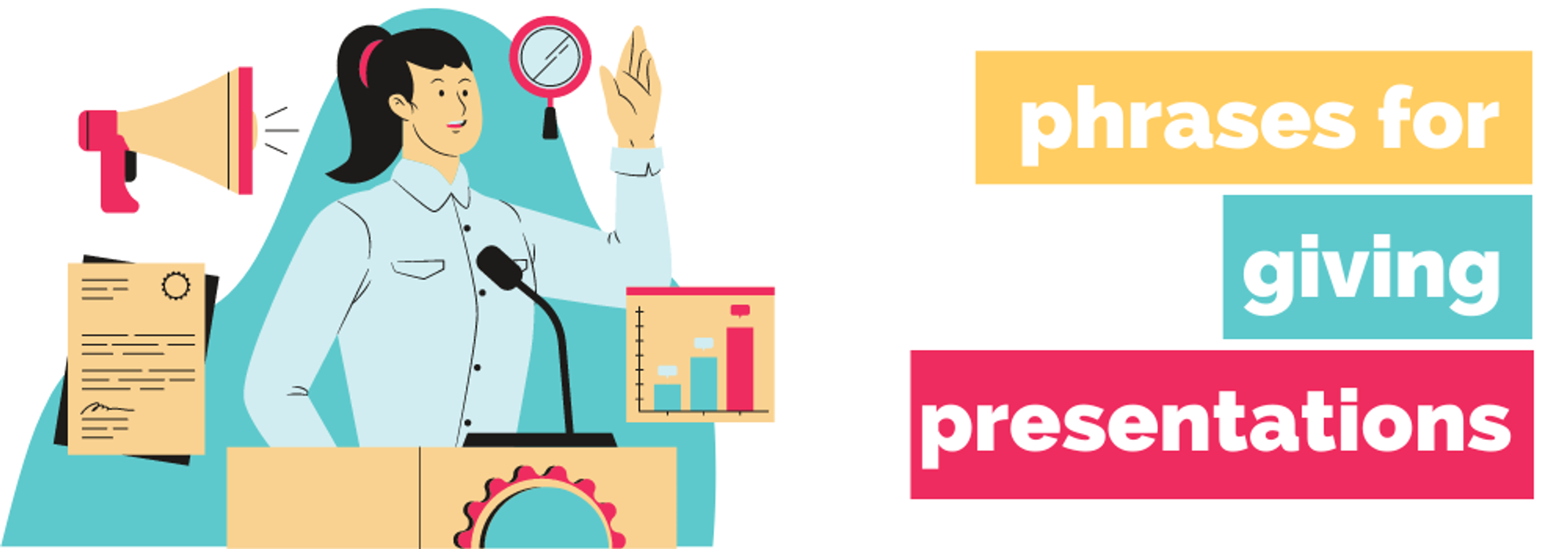
Giving a presentation is stressful for everybody. The last thing you want to worry about is the vocabulary you should use. Let’s practice that!
Before you start the class, download this file and print it. Use it as your notebook to write down your favourite phrases 📝
Buy me a cup of coffee! ☕
If you’d like to get those materials in PDF format, please buy me a cup of coffee through the "buy me a coffee" button on the website. Write me your email address and the title of the materials you’d like to get. The PDF will be sent to the email address provided promptly.
Buy me a cup of coffee here:
Conversation practice - Giving presentations
- Have you ever had stage fright? Describe how you felt.
- How can you overcome stage fright? Do you have some performance anxiety tips?
- When giving a presentation you should slow down at the beginning to give your audience time to get used to your accent. Do you agree with this statement?
- Using pauses when presenting is very powerful. When should you use pauses?
- Many people say that when speakers apologise for their English, they seem unconfident. Others think it makes you sound empathetic and warm. What is your opinion?
- Body language is an essential tool in building credibility and connecting with your listeners. presenting. Do you agree?
Introducing yourself
.jpg?table=block&id=e479f0ba-2b01-413b-9ef1-7cdb6e0ca111&cache=v2)
Exercise 1
Fill in the gaps.
Hello, everyone. Let me … introduce myself. My name is Elizabeth Walker, and I’m the Head of Research and Development … Green Innovations. I have been working … the field of sustainable technology for over 12 years, specialising … renewable energy solutions. … the past few years, I've had the opportunity … to be part of an innovative solar power project that significantly lowers our carbon emissions. Today's presentation … on the latest advancements in sustainable energy technologies and their impact on global environmental efforts.
Exercise 2
Create introductions for the following characters:
- Isabella Garcia, Marketing Strategist: - Position: Marketing Director at BrandBoost - Specialisation: Digital Marketing and Brand Strategy - Presentation Topic: "Revolutionizing Retail through Digital Branding” - Recent Achievement: Successfully rebranded a major retail chain
- Aiden Patel, Financial Analyst: - Position: Senior Financial Analyst at WealthWise - Specialisation: Investment Strategies - Presentation Topic: "Investment Strategies for a Post-Pandemic World” - Recent Achievement: Published a book on post-pandemic investment trends
- Liam Murphy, Educational Innovator - Position: Educational Consultant and Founder of EduFuturists - Specialisation: Innovative Educational Technologies - Presentation Topic: "Virtual Reality: Transforming the Future of Education” - Recent Achievement: Implemented a VR-integrated teaching programme
- Susan Kim, Security Specialist: - Position: Chief Security Officer at SecureNet - Specialisation: Internet Security and Data Protection - Presentation Topic: "Enhancing Data Security in the Digital Age” - Recent Achievement: Launched effective cybersecurity training program
Introducing the topic
Listen to these speakers. How did they introduce the topics of their presentations?
Click here to read the transcript of this video:
...but without further ado, I present to you how to spot a fable.
Click here to read the transcript of this video:
Lots of things probably come to mind when you hear the words ‘fake news’. But what you may not realise, is that fake news is your fault.
Click here to read the transcript of this video:
So, how does this happen? How does fake news become a thing? How does fake news become so prominent in our society? Well, to understand this we sort of have to go back a couple of years and uh look at the last 15 years of the information revolution.
💡prominent - important, famous, noticeable
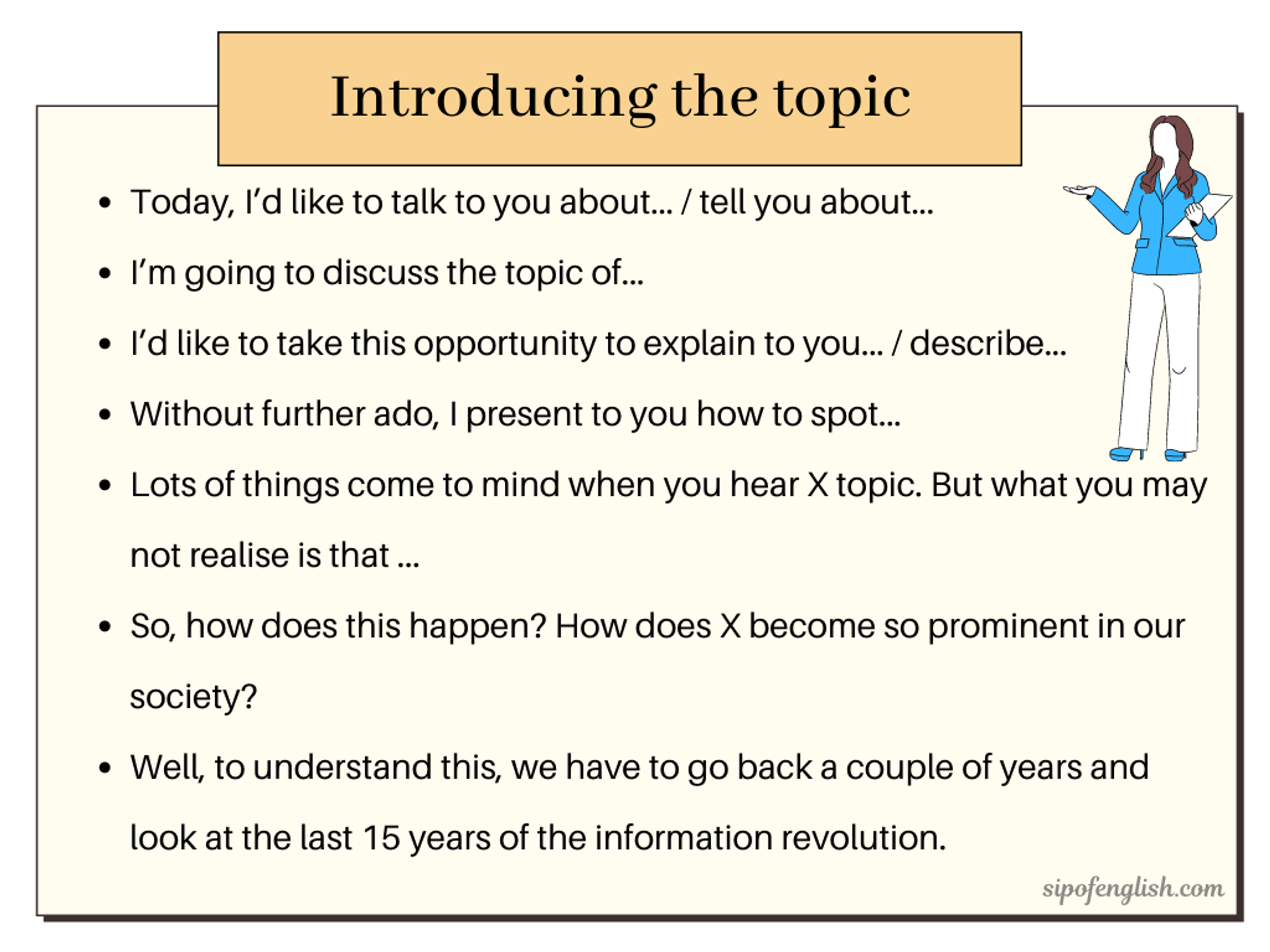
Exercise 3
Fill in the gaps.
Today, I’d like to talk to you … the issue of fake news in our digital age. I’m going to discuss the topic … how misinformation spreads and its impact on public opinion. Lots of things come to … when you … 'fake news.' But what you may not realise is that its influence extends far beyond just misleading headlines. Without further …, I present to you how to spot fake news and differentiate it from reliable information.”
Exercise 4
Use the phrases we’ve just learnt in the following scenarios:
- Topic: The Evolution of Virtual Reality
- Discussion: The advancements in technology and user experience over the last 15 years
- Potential problem: The risk of decreased physical activity and increased social isolation due to over-reliance on VR
- What comes to mind: High-tech gaming, immersive experiences
- What you may not realize: The potential of VR in education and therapy
- Topic: The Impact of Social Media on Mental Health
- Discussion: Examining the connection between social media usage and mental health
- Potential problem: The rise in anxiety and depression linked to social media use
- What comes to mind: Connecting with friends, sharing life updates
- What you may not realize: The challenge of moderating harmful content and its impact on young users
- Topic: The Environmental and Social Impact of Fast Fashion
- Discussion: The lifecycle of fast fashion products from production to disposal and its global impact
- Potential problem: The way fast fashion encourages people to buy and throw away clothes quickly, which harms the environment and treats workers unfairly.
- What comes to mind: Trendy, affordable clothing, and frequent new collections
- What you may not realize: The significant environmental damage and unethical labour practices often associated with fast fashion
Structure
After presenting your topic, you will have to order the points of your presentation. Listen to this speaker and fill in the gaps.
- There are about five different ... that I can think ... that we can follow to try and ... some of these very difficult problems today.
Click here to read the transcript of this video:
There are about 5 different paths, that I can think of, that we can follow to try and address some of these very difficult problems today. Each one of them has promise, but each one of them has its own challenges. The first one is labelling.
Here’s a great example in which the speaker says ‘What I want to address today is ...’ Take a look.
The first point
Listen to those speakers. How do they present their first points?
Click here to read the transcript of this video:
Is fake news real? First, the definition of fake news depends on where you sit. It’s not as if there’s extreme dictionary authority that gets to decide for everybody. Though some are trying, more on that in a moment. But when did fake news under anybody’s definition began? Well, fake news has always been...
Click here to read the transcript of this video:
Why? Why does false news travel so much further, faster, deeper and more broadly than the truth? The first hypothesis that we came up with was, “well, maybe people who spread false news have more followers or follow more people, or tweet more often, or maybe they’re more often ‘verified’ users of Twitter, with more credibility, or maybe they’ve been on Twitter longer”.
💡credibility - if those users have credibility, it means that they can be trusted
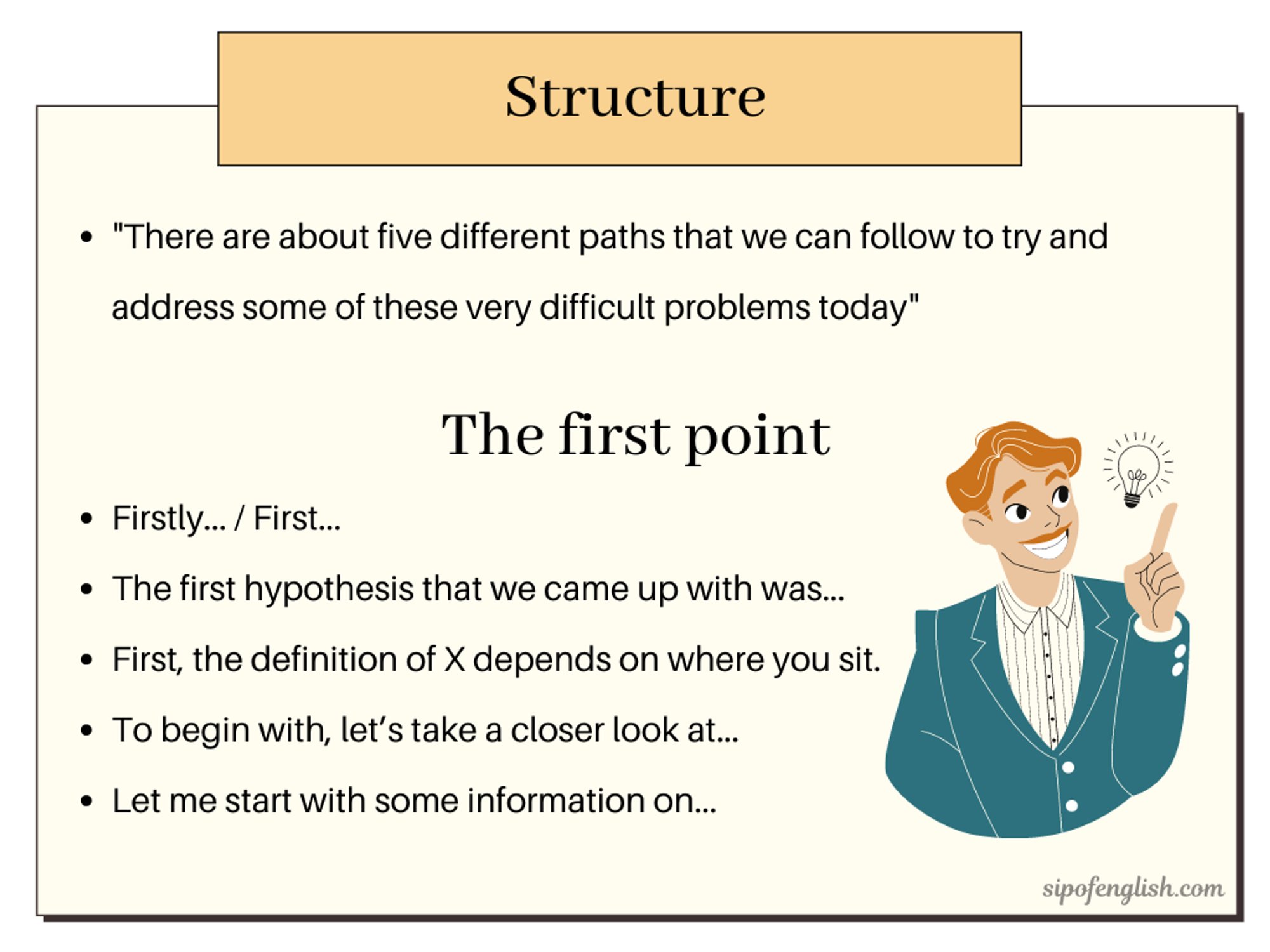
The next points
Listen to this speaker. What phrases does he use to present his next points?
Click here to read the transcript of this video:
...It would reduce the economic incentive to produce it at all in the first place. Third, we can think about regulation, and certainly we should think about this option. In the United states, currently...
💡incentive - an incentive is something that is supposed to encourage people to do something, e.g. Bonus money was a great incentive for many employees to work harder.
Click here to read the transcript of this video:
The fourth possible option is transparency. We wanna know. How do Facebook’s algorithms work?
💡transparency - the quality of operating without secrets
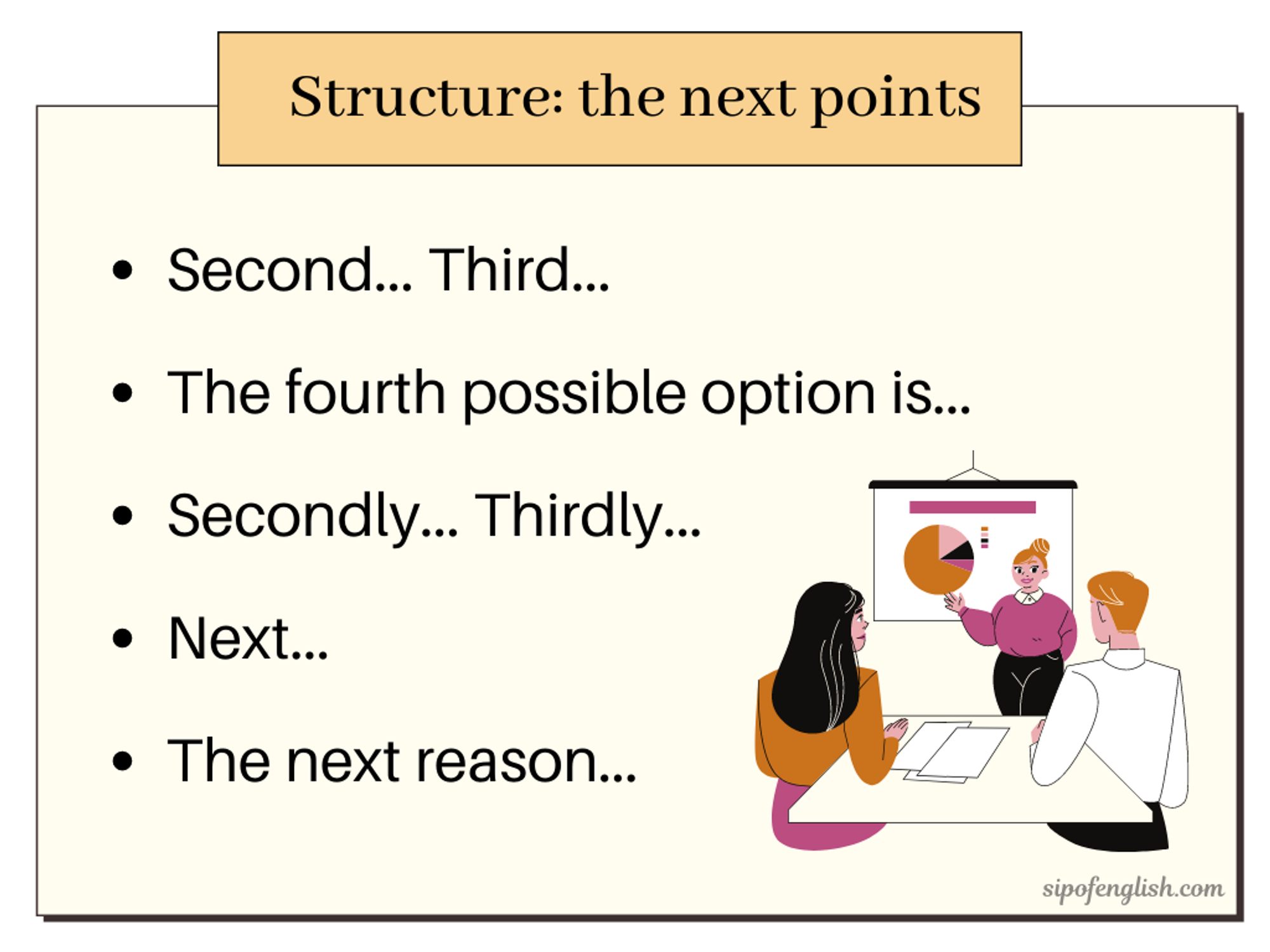
The final point
Listen to those speakers. What phrases do they use to present their final points?
Click here to read the transcript of this video:
The final thing that we could think about is algorithms and machine learning. Technology devised to root out and understand fake news, how it spreads, and to try and dampen its flow.
💡devise - invent a plan or a system
💡root out - remove, e.g. to root out corruption in the government
💡dampen its flow - slow down the spreading of fake news
Click here to read the transcript of this video:
People like the drama and they wanna be a part of it. That’s why you need to use care before you share. And finally, ‘you control the media’. And I’m not talking about social media and what you post on your own platforms, I’m talking about traditional media.
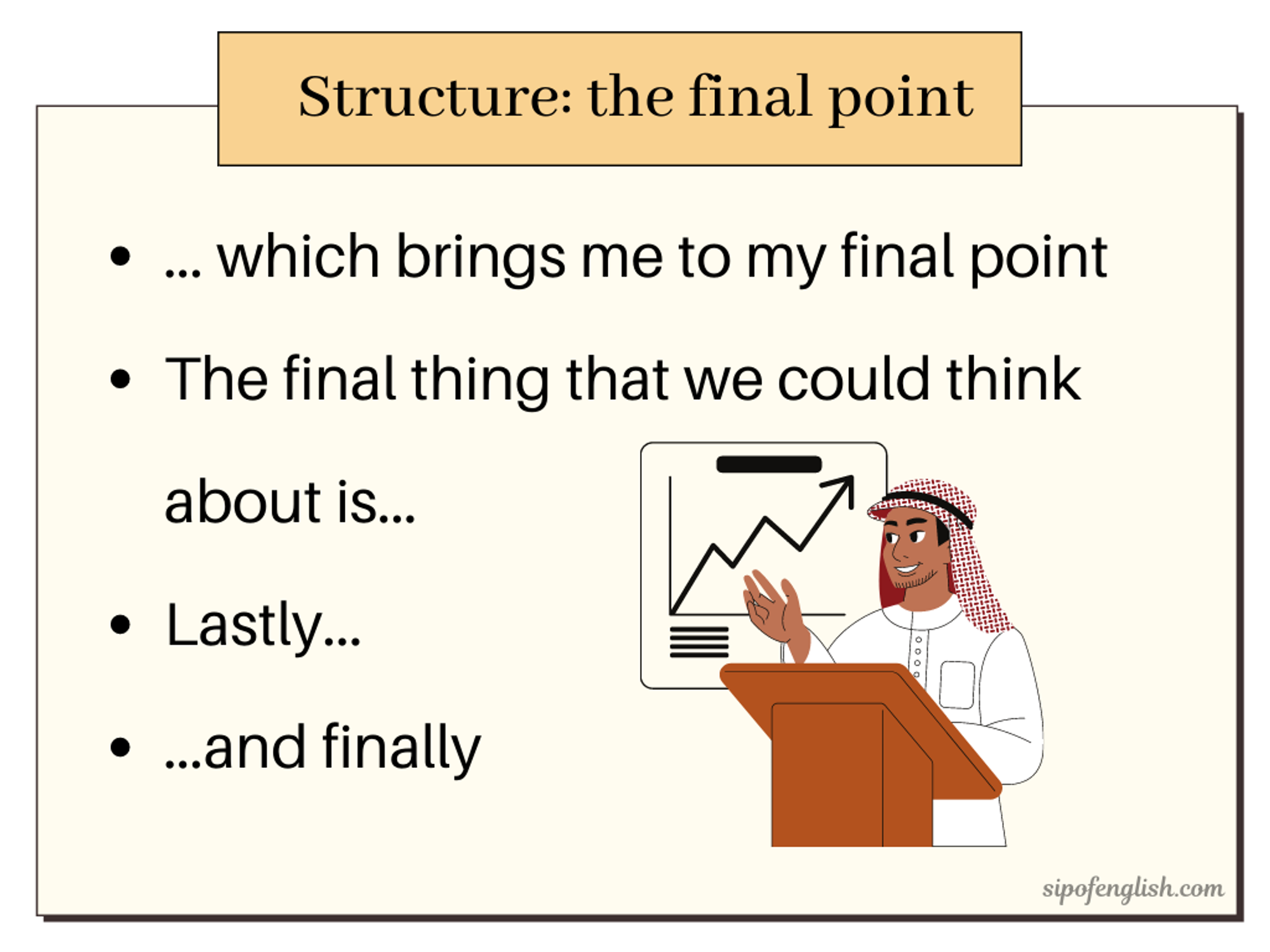
Exercise 5
Fill in the gaps.
…, let's establish what fast fashion is and why it has become a topic of global concern. The … of fast fashion depends on where you ... For consumers, it's about staying stylish on a budget; for environmentalists, it's a cause of concern due to its ecological footprint.
Let me … with some information … how fast fashion affects water resources. The production of one cotton shirt, for instance, can use about 2,700 litres of water — equivalent to what an average person drinks in 2.5 years.
…, we should consider the labour practices in the fast fashion industry. Often, workers in developing countries are subjected to poor working conditions and low wages.
…, let's discuss the quality and lifespan of fast fashion products. These items are typically made with lower quality materials and are designed to be disposable.
Which brings me to my final …: the potential solutions and alternatives to fast fashion. This includes buying second-hand, choosing quality over quantity, and supporting brands with sustainable practices.
Exercise 6
Use the phrases we’ve just learnt in the following scenarios:
- Topic: The Benefits and Challenges of Remote Work
- Definition of home office: A designated workspace at home for professional work.
- Extra information: Remote work gained significant popularity in recent years since the COVID-19 pandemic.
- First point: Flexible schedules for improved work-life balance.
- Second point: Reduced commuting and office expenses benefit employees and employers.
- Next point: Problem of isolation, distractions, and work-life boundaries through effective time management
- Final point: Employers need to focus on maintaining employee well-being and engagement in a virtual work environment.
- Topic: The Impact of Social Media on Society
- Definition of home office: Online platforms and websites that allow users to create, share, and interact with content and connect with others virtually.
- Extra information: The rise of social media has transformed how people communicate, share information, and connect with one another in the digital age.
- First point: Social media platforms have revolutionized communication by connecting people across the globe.
- Second point: Social media has become a powerful tool for sharing news, opinions, and trends, influencing public discourse and shaping opinions.
- Next point: The increased use of social media has raised concerns about data privacy, cyberbullying, and online security.
- Final point: It's essential for individuals to practice critical thinking, online etiquette, and safeguarding personal information.
- Topic: The Evolution of Artificial Intelligence
- Definition of home office: The development of computer systems that can perform tasks that typically require human intelligence, such as learning, reasoning, problem-solving, and decision-making.
- Extra information: AI technology has witnessed rapid advancements in recent years, leading to its integration into various industries and applications.
- First point: The role of AI in revolutionising healthcare, from diagnostic algorithms to personalised treatment plans.
- Second point: AI is used in the finance sector for risk assessment, fraud detection, and algorithmic trading.
- Next point: People are becoming overly reliant on AI for decision-making. There’s a trend of self-diagnosing health issues instead of consulting healthcare professionals.
- Final point: AI developers and organisations should address biases, privacy concerns, and potential misuse of AI technology.
Elaborating on your points
Listen to those speakers. What phrases do they use to expand on their ideas?
Click here to read the transcript of this video:
And, the story got so big that Snapchat itself had to come out and put out a statement, and say ‘hey, we’re not shutting down, this is #Fakenews. Let’s think about this for a second. Snapchat is a multibillion-dollar company that is listed on the New York stock exchange. A piece of fake news was so powerful that they had to come out and make a statement.
💡make a statement - to officially express opinion on some topic
Click here to read the transcript of this video:
A recent study by Oxford University showed that in the recent Swedish elections, one third of all of the information spreading on social media about the election was fake or misinformation. In addition, these types of social media misinformation campaigns can spread what has been called ‘genocidal propaganda’. For instance, against the Rohingya in Burma triggering mob killings in India.
💡misinformation - wrong information
💡genocidal propaganda - information that leads to murdering a group of people
💡trigger - cause a situation to start
💡mob - a large, angry crowd
Click here to read the transcript of this video:
So to understand people’s perceptions of false news, we looked at the information and the sentiment contained in the replies to true and false tweets. And what we found was that across a bunch of different measures of sentiments - surprise, disgust, fear, sadness, anticipation, joy and trust false news exhibit significantly more surprise and disgust in the replies to false tweets.
💡sentiment - general opinions and feelings about some situation
💡exhibit - to show
💡significantly more - much more
Click here to read the transcript of this video:
I really believe that we must all start to ask tougher questions of information that we discover online.
💡tough question - a question that is difficult or uneasy to answer
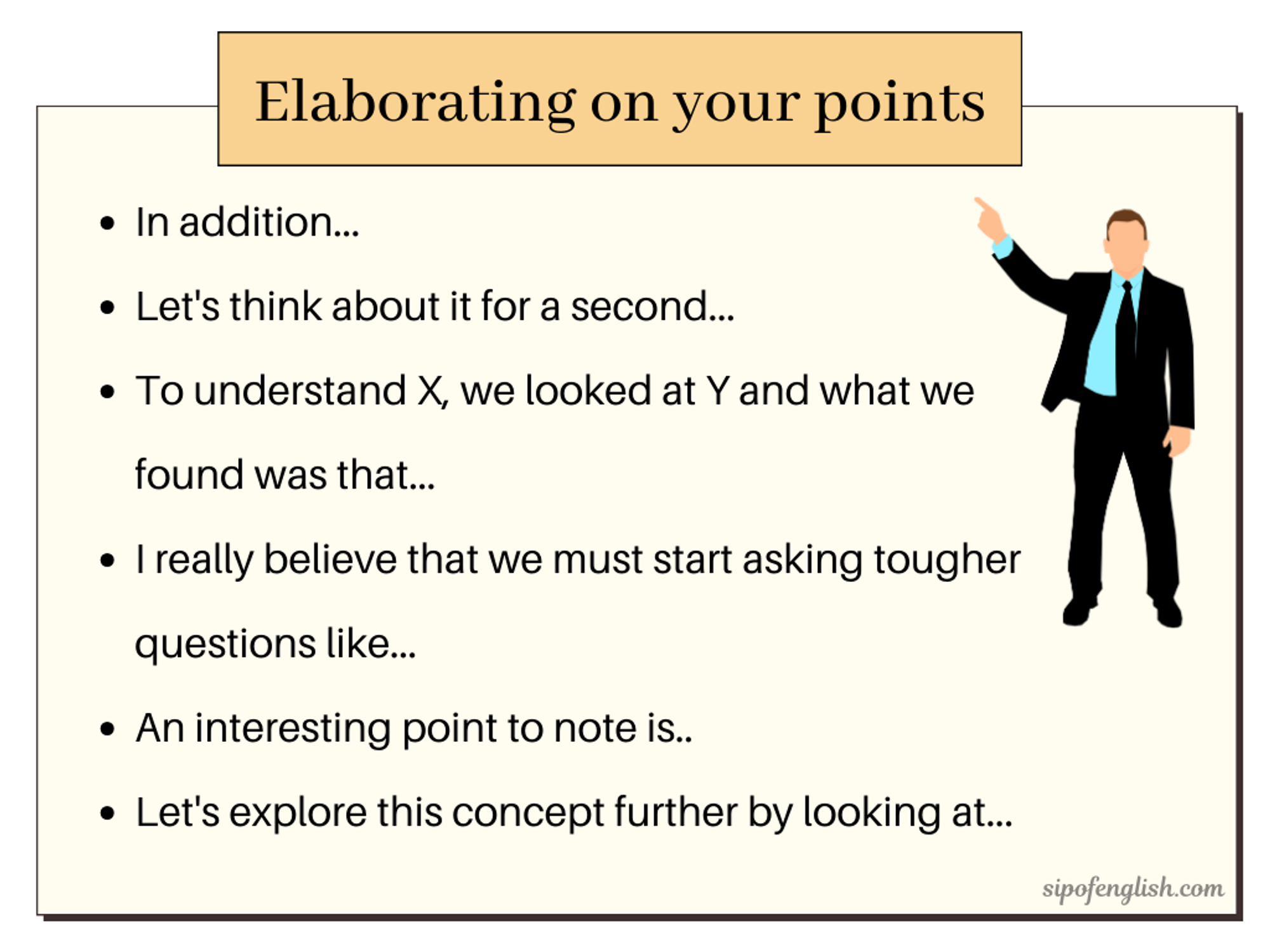
Exercise 7
Fill in the gaps.
Let's think … second. What makes a work-life balance so challenging in today's world? An interesting point to … is the rise of technology. While it has made our work easier, it also means we are always connected, making it hard to switch off from work.
In a…, the pressure to succeed at work can often lead to long hours and stress. But, I really believe that we must start asking t… like, 'How can we set healthy boundaries between our work and personal lives?'
To … this, let's look at the concept of 'digital detox', where people choose to disconnect from digital devices for a certain period.
Exercise 8
Use the phrases we’ve just learnt in the following scenarios:
- Topic: Discussing the importance of mental health awareness.
- “Let’s think about it for a second…”: Prompt the audience to reflect on how often we really pay attention to our own mental well-being
- “To understand X, we looked at Y”: To understand the impact of daily stress, look at recent workplace studies. What we found was that a high percentage of people feel overwhelmed regularly.
- “An interesting point to note is…”: Highlight the role of social media in shaping our perceptions of mental health.
- “In addition…”: Add information about how research shows that regular exercise and healthy eating habits can significantly improve mental health.
- “I really believe that we must start asking tougher questions like…”: Encourage deeper questioning, such as 'How can we make mental health support more accessible to everyone?'
- “Let’s explore this concept further by looking at…”: Examine specific strategies to improve mental health support, focusing on the implementation and impact of mindfulness and meditation programs in schools.
- Topic: The Role of Technology in Modern Education
- “Let’s think about it for a second…”: Encourage the audience to reflect on how technology has changed the way we learn and teach.
- “To understand X, we looked at Y”: To understand student engagement, examine the use of interactive digital tools in classrooms. Findings show increased participation and interest.
- “An interesting point to note is…”: Discuss how technology in education allows for the accommodation of different learning styles, making education more inclusive and effective for various learners.
- “In addition…”: Add information about how online learning platforms have made education more accessible, especially during the pandemic.
- “I really believe that we must start asking tougher questions like…”: Consider ethical challenges in educational technology. It is difficult to protect student privacy in the digital age.
- “Let’s explore this concept further by looking at…”: Let’s look at strategies schools can implement to strengthen data security.
Giving examples
Do you know any synonyms of ‘for example’? Listen to this speaker to find out.
Click here to read the transcript of this video:
That is a potential avenue, but it comes with its challenges. For instance, who gets to decide in society what’s true and what’s false? Is it the governments? Is it Facebook?
💡avenue - an avenue is a wide road but in this context it’s a metaphor. This speakers means ‘a way / path to solve the problem’ by saying ‘an avenue’
💡potential - possible
Here’s one more example, from FRIENDS.
Click here to read the transcript of this video:
Did you know that the word ‘like’ can also be used to introduce an example? Take a look at these clip below.
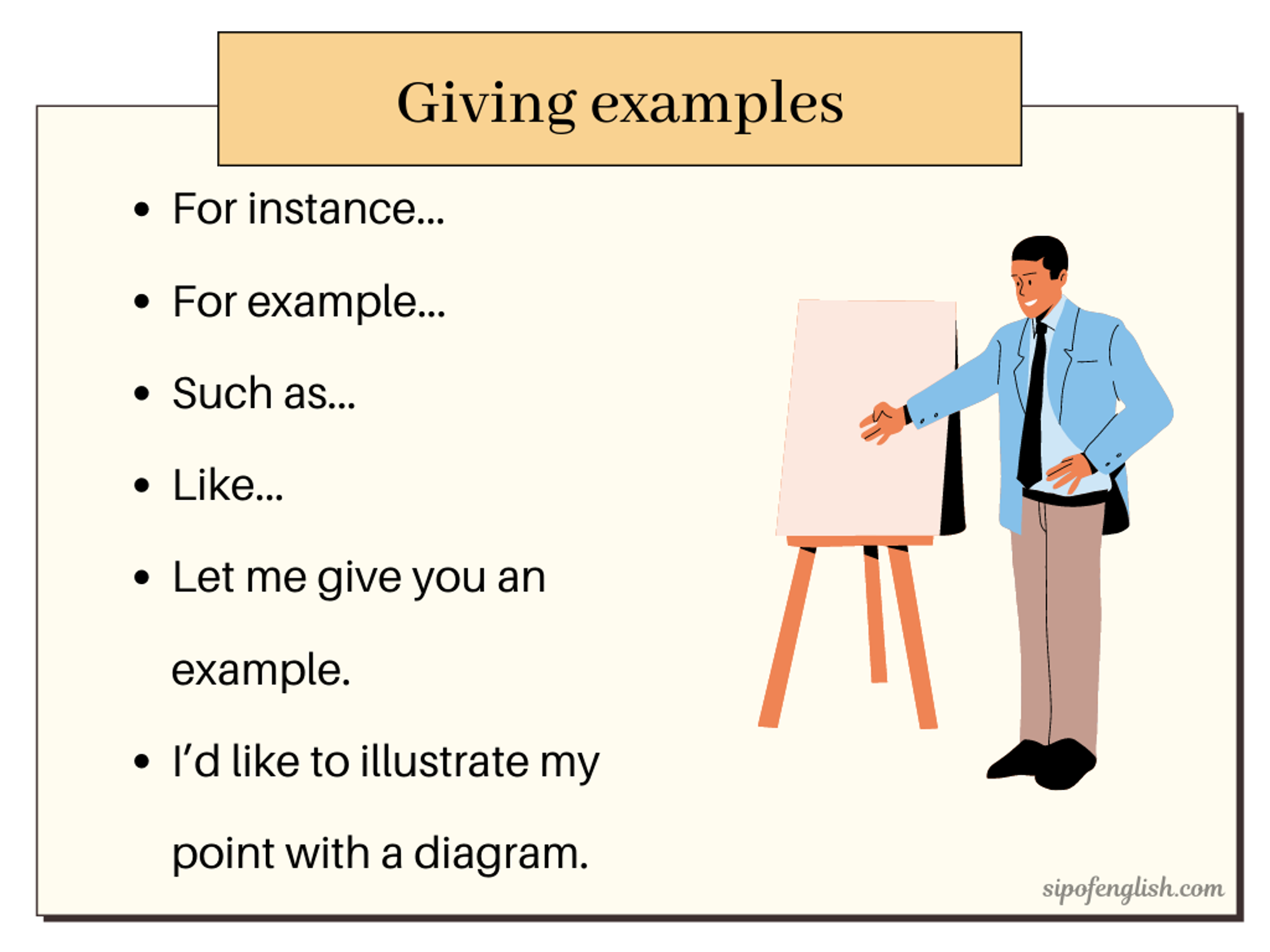
Exercise 9
Fill in the gaps.
Today, let's delve into the topic of healthy eating habits. For i…, incorporating a variety of fruits and vegetables into our diet is fundamental for good health. These items are not just food; they're sources of vital nutrients and vitamins. For e…, carrots are not only delicious but are also packed with Vitamin A, which is essential for good vision. Now, let me … you an example of making healthier food choices. When faced with the option of having a fruit salad or a slice of cake, choosing the fruit salad is not only beneficial for maintaining a healthy weight but also for ensuring long-term well-being. Foods l… fruits and vegetables should be staples in our diet for their immense health benefits.
Exercise 10
Use the phrases we’ve just learnt in the following scenarios:
- Topic: The Impact of Regular Exercise on Health Introduction: Today, we're going to explore the significant benefits of regular exercise on our overall health and well-being.
- “For instance…”: Explain that regular exercise has proven beneficial for health. Example: A recent study showed that people who exercise regularly have a lower risk of developing heart disease.
- “For example…”: Give an example that supports the importance of exercise. Example: Jogging for 30 minutes a day can significantly improve cardiovascular health.
- “Such as…”: Mention specific types of exercises and their benefits. Example: Engaging in activities … swimming, cycling, and yoga can not only boost physical fitness but also mental well-being.
- “Like…”: Introduce similar examples to make a point. Example: Regular physical activities, … brisk walking and strength training, are known to enhance muscle strength and endurance.
- “Let me give you an example…”: Present a real-life scenario. Example: An example of a friend who overcame obesity by adopting a consistent exercise routine.
- Topic: The Advantages of Renewable Energy Sources Introduction: In today's discussion, we're going to examine the various advantages of using renewable energy sources over traditional fossil fuels.
- “For instance…”: Point out a specific benefit of renewable energy. Example: Solar panels provide a clean and sustainable way to generate electricity without emitting greenhouse gases.
- “For example…”: Give a clear example highlighting the effectiveness of renewable energy. Example: Wind turbines can produce significant amounts of electricity even in areas with moderate wind speeds.
- “Such as…”: Mention particular types of renewable energy and their unique advantages. Example: Renewable sources … hydroelectric power, biomass, and geothermal energy are continuously available and help in reducing our dependence on fossil fuels.
- “Like…”: Introduce more examples to illustrate the point. Example: Renewable energy projects, … solar farms and offshore wind farms, not only generate electricity but also create new jobs and boost local economies.
- “Let me give you an example…”: Present a real-life scenario. Example: Iceland has successfully transitioned to almost 100% renewable energy, showcasing the potential for large-scale change.
Ending the presentation
Listen to those speakers. Pay attention to how they concluded their presentations.
Click here to read the transcript of this video:
What if we stop to think about the real-life consequences of the information that we share? Thank you very much for listening.
Click here to read the transcript of this video:
I’ll leave you with a final thought and a warning. It’s about a new catchphrase being bandied about - ‘media literacy’.
💡 catchphrase - a famous phrase that is associated with a person or a company, e.g. McDonald’s ‘I’m Lovin it’
💡bandy sth about - to mention something very often
💡media literacy - the ability to analyse media messages
Click here to read the transcript of this video:
So, what’s the lesson in all of this? I’m not here to litigate who’s right but I can tell you there are two ways to tell that powerful interest might be trying to manipulate your opinion. Number one, when the media seems to be trying to shave or censor facts and opinions rather than report them. Number two, when so many of the media are reporting the same stories promulgating the same narratives, relying on the same sources, even using the same phrases.
💡misinformation - wrong information
💡litigate - take a dispute to a court, legally judged
💡tell - in this context, it means to recognise, to know
💡powerful interest - in this context, it describes a powerful person or people, e.g. a company, politician, etc.
💡shave - generally it means to remove hair, e.g. shave legs. In this context, however, it means to remove some information
💡promulgate - spread information among many people
💡narrative - a description of events, a story
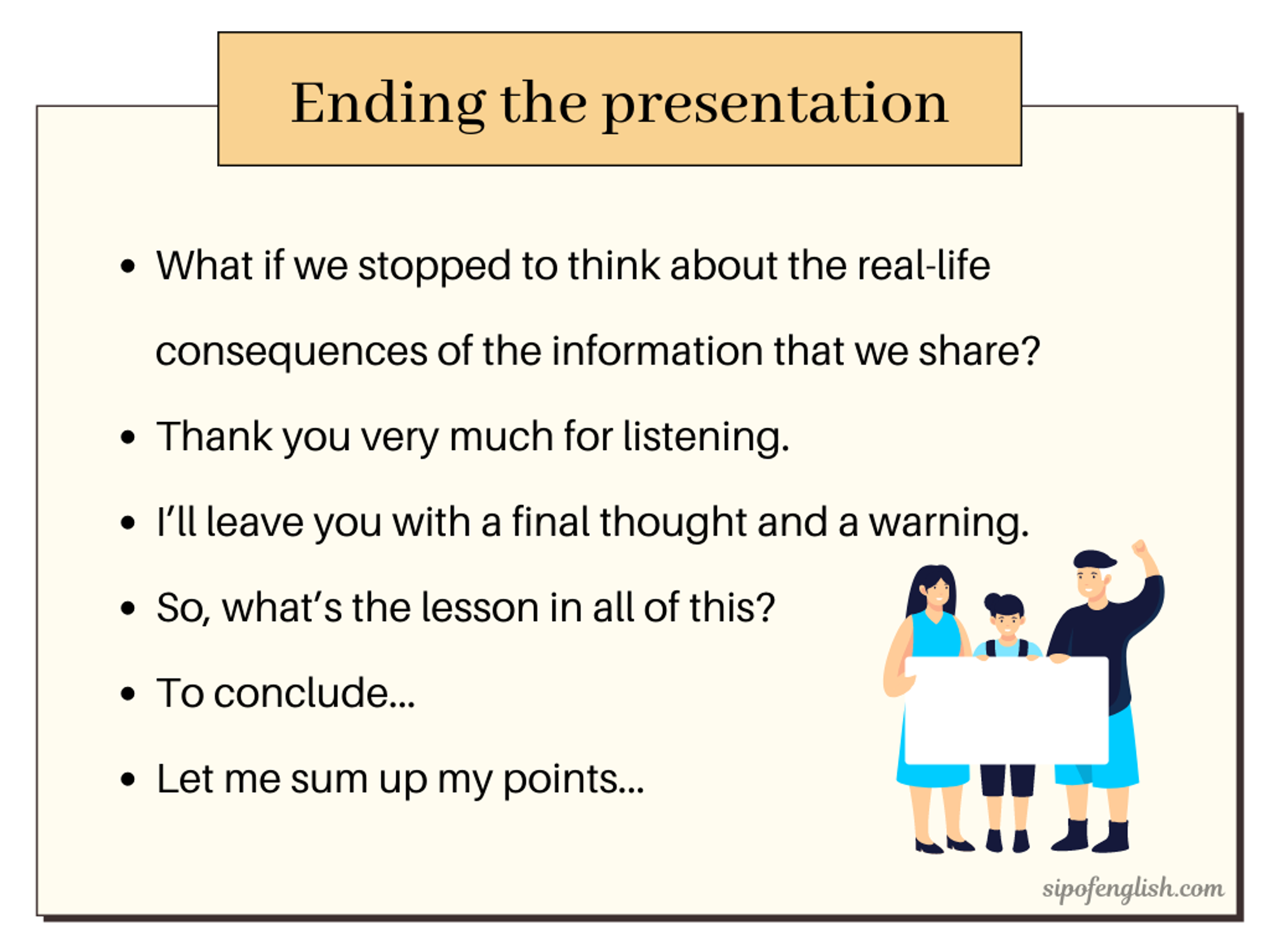
Other useful phrases
How does this speaker say that she will talk about a certain topic later, not now?
Click here to read the transcript of this video:
Is fake news real? First, the definition of fake news depends on where you sit. It’s not as if there’s extreme dictionary authority that gets to decide for everybody. Though some are trying, more on that in a moment. But when did fake news under anybody’s definition began? Well, fake news has always been...
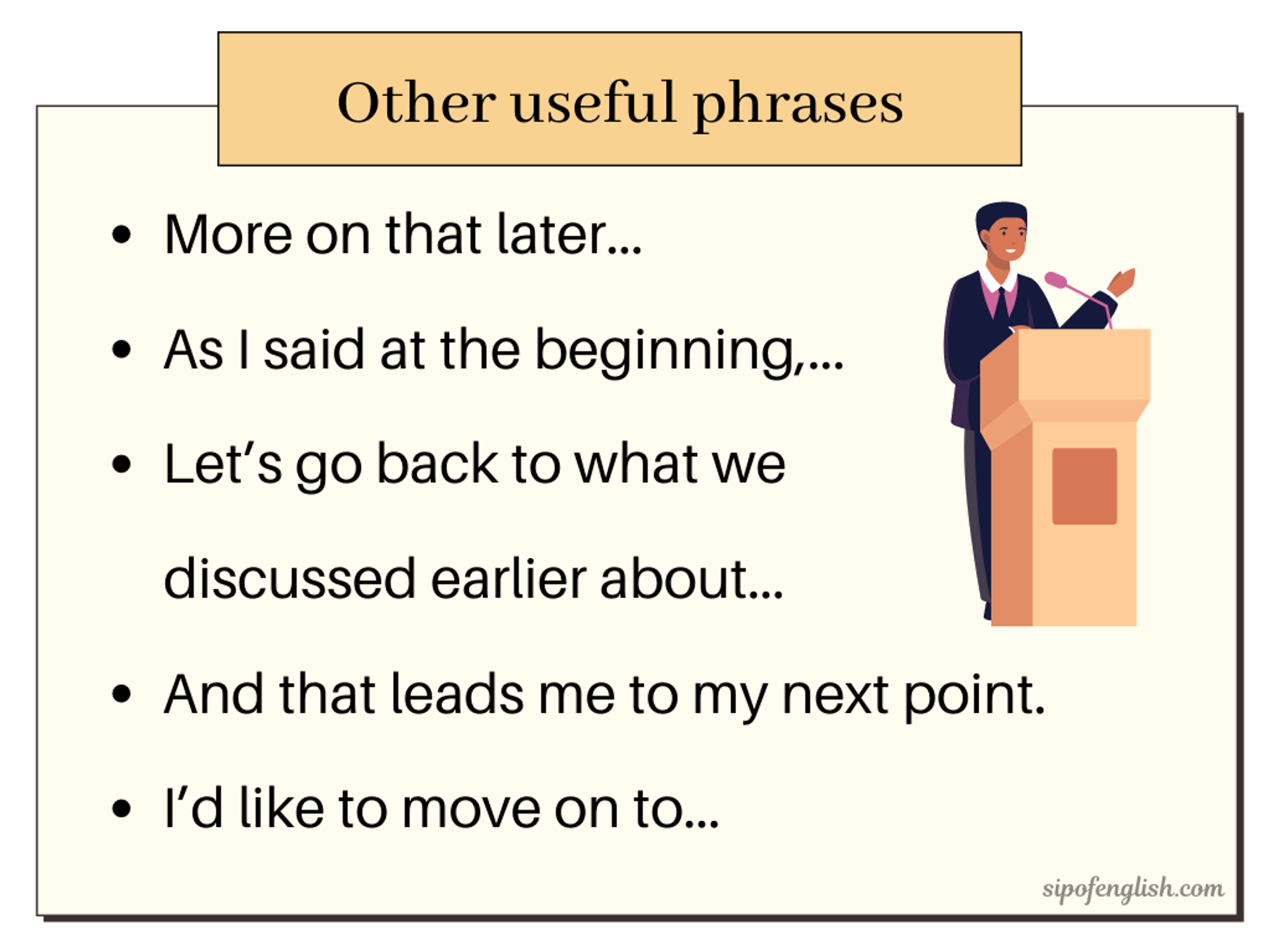
Let’s practise!
Download this document and print it. Choose around three phrases from each section and write them down.

Online vs. traditional school: Which is the better choice?
- Introduce yourself and tell your listeners briefly about your experience with online learning.
- Introduce the topic of your presentation. Summarise the history of online learning. Here are a few fun facts you can talk about:
→ The first computer-based education programme was introduced in 1960. The University of Illinois linked a few computer terminals together to give their students access to the recorded lectures and materials.
→ At first, this system was introduced at the University of Illinois but with time more schools started copying that system.
→ The concept of distant learning gained popularity. Schools started sending materials to students by post. Students also contacted their teachers via post.
→ The Internet was invented in 1983 and revolutionised distance learning.
→ The coronavirus outbreak resulted in schools shutting down around the world. Students and teachers were forced to adapt to online learning.
- Talk about the pros and cons of online education. Think of your own examples or use the ones listed below.
- Pros: - being able to study from the comfort of your home - students aren’t bullied by their peers - online education is cheaper than traditional education - access to academic resources at all times
Cons:
- lack of social interaction
- technical difficulties
- less control over students, e.g. if students mute their microphones and turn off cameras, teachers don’t know if they’re present
- Summarise your points. Leave your audience with a final thought, a warning or a question.
Presentation topic ideas!
Look for an interesting article on www.nationalgeographic.com, and prepare a presentation based on it.
Homework assignment
Now that you’ve studied hard to master the phrases you can use while giving presentations, let’s relax and have a bit of fun 😀 As your homework assignment, watch this hilarious presentation on how to sound smart when presenting.

























